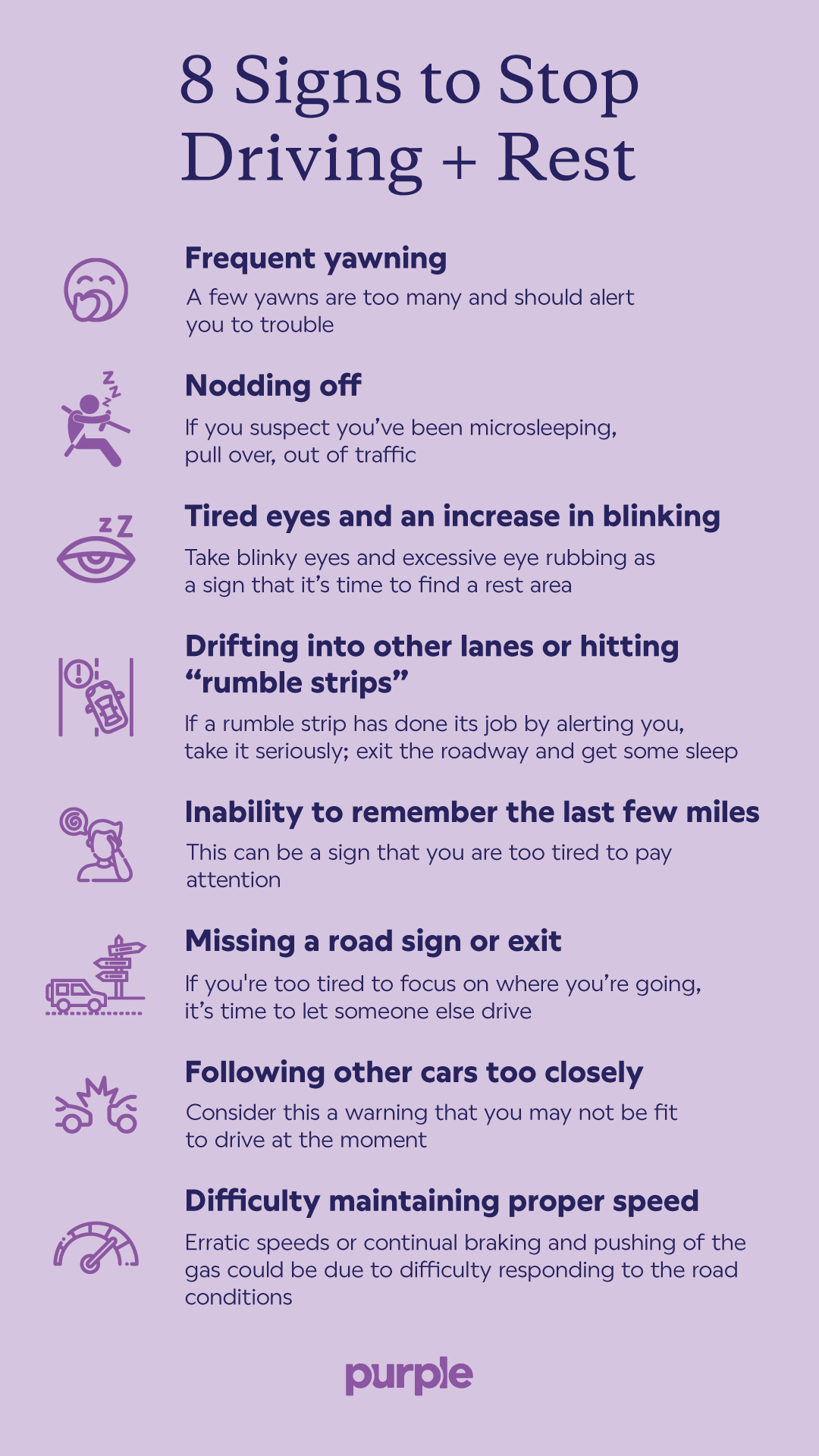Guide To Preventing Drowsy Driving
Driving may not be something we think a lot about, as many of us have been doing it since we were teenagers. But with great freedom comes great responsibility, and it only takes one poor night of sleep to negatively affect how you drive and pose yourself as a risk to others on the road.
Drowsy driving is a risky behavior that you may not even realize you are doing. However, you don’t have to be aware of it for it to create harmful consequences. Learn what it means to drive drowsy, how to prevent it, and why distracted driving can have consequences for you and everyone around you.
What Is Drowsy Driving?
Drowsy driving is driving while being overly tired or sleepy. It creates a dangerous situation behind the wheel.
The causes for drowsy driving vary, but the result is that a driver may find it difficult to pay attention to the road, have a slower reaction time, and show decreased decision-making ability.
The driver may not even realize they are exhibiting these behaviors, but the risk is the same. According to the CDC, an estimated 633 deaths occur in the United States each year from reported drowsy driving incidents, but the numbers are likely higher.
Who Is At The Most At Risk Of Drowsy Driving?
Anyone who gets behind the wheel could experience drowsy driving, but some groups are more likely to experience it. They include the following:
- Teens, young drivers, and new drivers
- Those driving between midnight and 6 a.m.
- Those driving in the late afternoon
- Those without enough sleep
- Those who work long shifts or late shifts
- Those with untreated sleep disorders
- Those who use certain medications
Commercial truck drivers are also at increased risk, since they may make up several of these categories at once and drive more than the average person.
Causes Of Drowsy Driving
You can see from the list of who is most likely to drive drowsy that there is no single cause for it. Drowsiness happens from many causes, and it’s possible to have multiple factors affecting your driving.
Medication
Many prescription and over-the-counter medications (OTC) affect your ability to drive. They may have side effects that make you drowsy and can slow your movement or disrupt your vision. Medications that can make you sleepy may be marked with a warning to not use them while operating heavy machinery, which includes cars.
A wide range of medications may make you sleepy, including opioid pain relievers, anti-anxiety medications, antipsychotic medications, antidepressants, cold medicines (including those for allergies, anti-diarrheal medications, and muscle relaxants. Even diet pills and those containing stimulants can have the opposite effect and make you tired. CBD products are also known to have lethargy and sedation as side effects, regardless of how you ingest them.
While you may quickly learn how different medications affect you, some can take longer than others to clear your system. For example, sleeping pills, like Ambien, may affect you until the next day, so don't assume you have "slept off" the effects of the medication until you know how you will react.
Follow directions for any medications, and talk to your doctor if you experience drowsiness that interferes with driving or if you are concerned about how different medications interact with one another.
Lack of Adequate Sleep
It would make sense that a poor night’s sleep would make you feel sleepy the next day and affect how you drive. The stats back up this assumption:
In the same report from the CDC, 1 in 25 drivers claimed to have fallen asleep while driving in the past month. The same group of drivers showed a higher likelihood of falling asleep while driving if they regularly got less than 7 hours of sleep or snore.
Good sleep is essential for many health benefits, but now we also know that it can create a dangerous scenario for you and others on the road.
Age
Age already has some influence on driving, and everyone ages differently. Older drivers should be aware of any signs of decreased driving ability, whether it be from reduced eyesight, flexibility, or simply being too tired in the evenings to stay alert. Asking a friend or family member to assess driving may be a smart move, as well as communicating with a physician about any sleepiness experienced during driving sessions. There may be a medical cause beyond the natural aging process.
Younger drivers are less experienced and may not understand their physical limits when tired. They could even overestimate how well they drive during drowsy periods. Educating young drivers on the symptoms of drowsy driving and the risks associated with it is a necessary first step to helping them drive safely.
Signs That You Should Stop Driving To Rest
How can you know if you're too tired to drive? It may be difficult for drowsy drivers to know if there’s a true risk of falling asleep or causing an accident. Pull over immediately if you catch yourself doing any of the following. You’ll need to catch a few winks before you resume your road trip.
Frequent yawning
Yawns have a way of making you yawn even more. Not only is yawning a sign of exhaustion, but it can distract you from seeing the road. (We usually close our eyes when we yawn.) A few yawns are too many and should alert you to trouble.
Feelings of dozing off
Did you really fall asleep? If you suspect you’ve been microsleeping (taking short sleep sessions of 30 seconds or less), do everyone a favor and pull over. Any amount of sleep at the wheel is too much.
Tired eyes, droopy eyes, or an increase in blinking
You'll probably know when you're exhausted because your eyes will have difficulty staying open. Blinking repeatedly may be your way of trying to stay alert, but this isn't a good tactic and won't actually help you stay awake. Take blinky eyes and excessive eye rubbing as a sign that it’s time to find a rest area.
Drifting into other lanes or hitting “rumble strips” on the road
Rumble strips are the rough tread tracks along the side of the road that make a loud “rumbling” noise if you run over them. They are designed to wake up sleepy drivers who might veer too far onto the shoulder, and they may be making a difference.
Studies show that they may reduce between 20% to 70% of the run-off-road (ROR) accidents that happen each year, usually single-vehicle accidents where just the driver is involved. So if a rumble strip has done its job by alerting you, take it seriously; exit the roadway and get some sleep.
Inability to remember the last few miles
It's easy to get too familiar with our journey to work or home and not pay close attention to every house we pass or road we cross. Having no memory of pieces of the trip, however, can be a sign that you are too tired and possibly have slept through part of it.
Worse yet, if you find yourself lost or unsure of your current point in your journey, without looking at your GPS to reassess if you should be driving at all.
Missing a road sign or exit
If you get confused or lost because the area is unknown to you, it's not altogether a reason to worry. However, missing an exit you are familiar with could be a symptom that you didn't see because you were sleeping. If you're too tired to pay close attention to where you are going, it’s time to let someone else drive.
Following other cars too closely
It’s never safe to tailgate other cars, and doing it while tired is especially dangerous. Creeping up on the back end of another vehicle is one sign of being too tired or unresponsive to drive well. Consider it a warning that you may not be fit to drive at the moment.
Difficulty maintaining proper speed
Cruise control is an amazing technology that may cover up our actual ability to drive. What if you had to turn it off? Could you still maintain a steady and appropriate pace for the posted speeds? Erratic speeds or continual braking and pushing of the gas could be due to difficulty responding to the road conditions. For some people, they are warning signs of being too tired to continue driving.
What To Do If You Feel Tired While Driving
In a perfect world, you’ll get enough sleep to not have to drive tired. However, it’s possible that you could feel too drowsy while on the road to continue safely. In this case, the best thing to do is stop driving, at least for a time, so you can get proper rest before resuming.Let someone else take the wheel, if possible.
It’s not always ideal to stop where you are, so getting to a safe place takes precedent. You don’t want to stop on the side of a busy freeway or in a place where you’re now allowed to park. A rest stop on the highway, business parking lot, or hotel can all give you time needed to rest for a bit.
The CDC recommends that you not try to continue driving. Many of the common “tips” for staying awake include rolling down your windows or listening to music, but these may only temporarily keep you alert and don’t do anything to help you rest. You are still just as dangerous while doing these things, and sleep is the only way to get back into good driving condition.
Even if you can only take a nap, it’s beneficial. Resume driving only after you’ve had some needed rest and can get back on the road without putting yourself and others in harm’s way.

